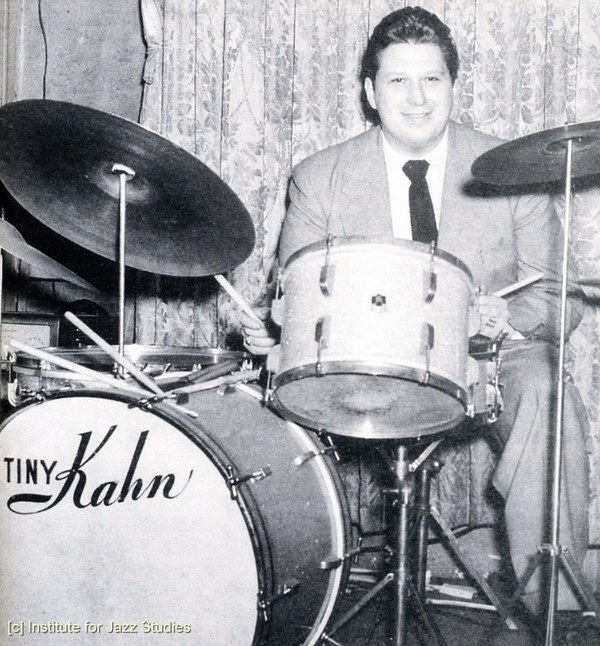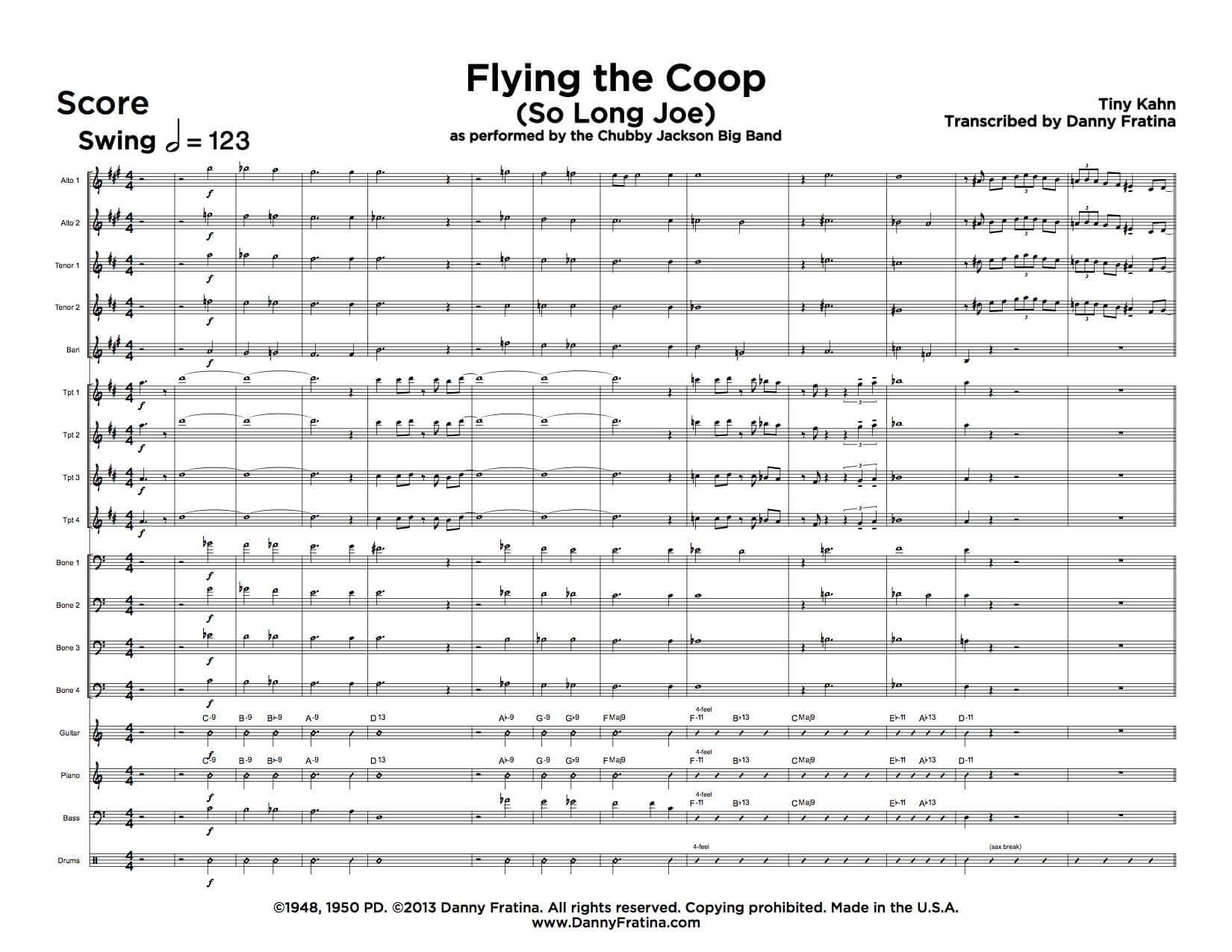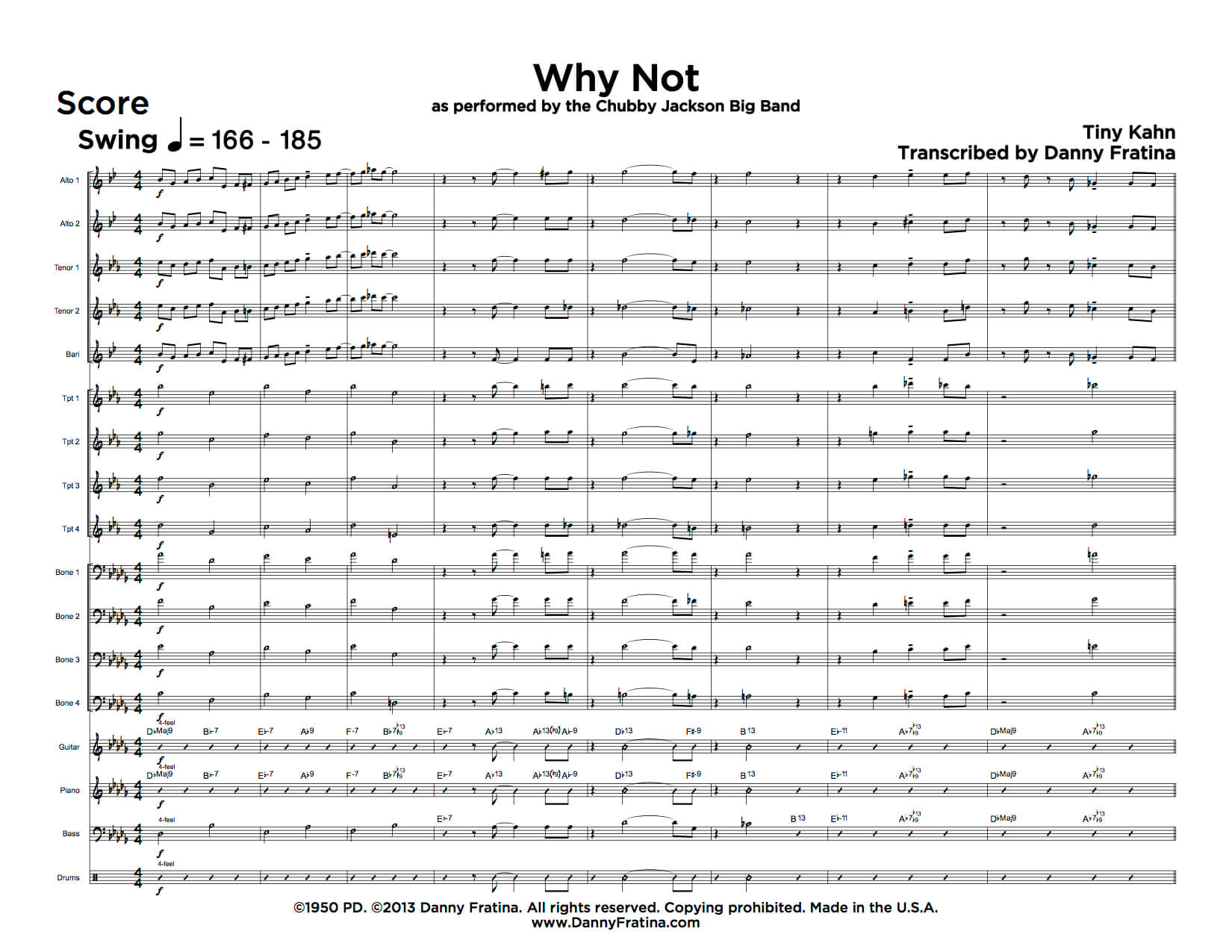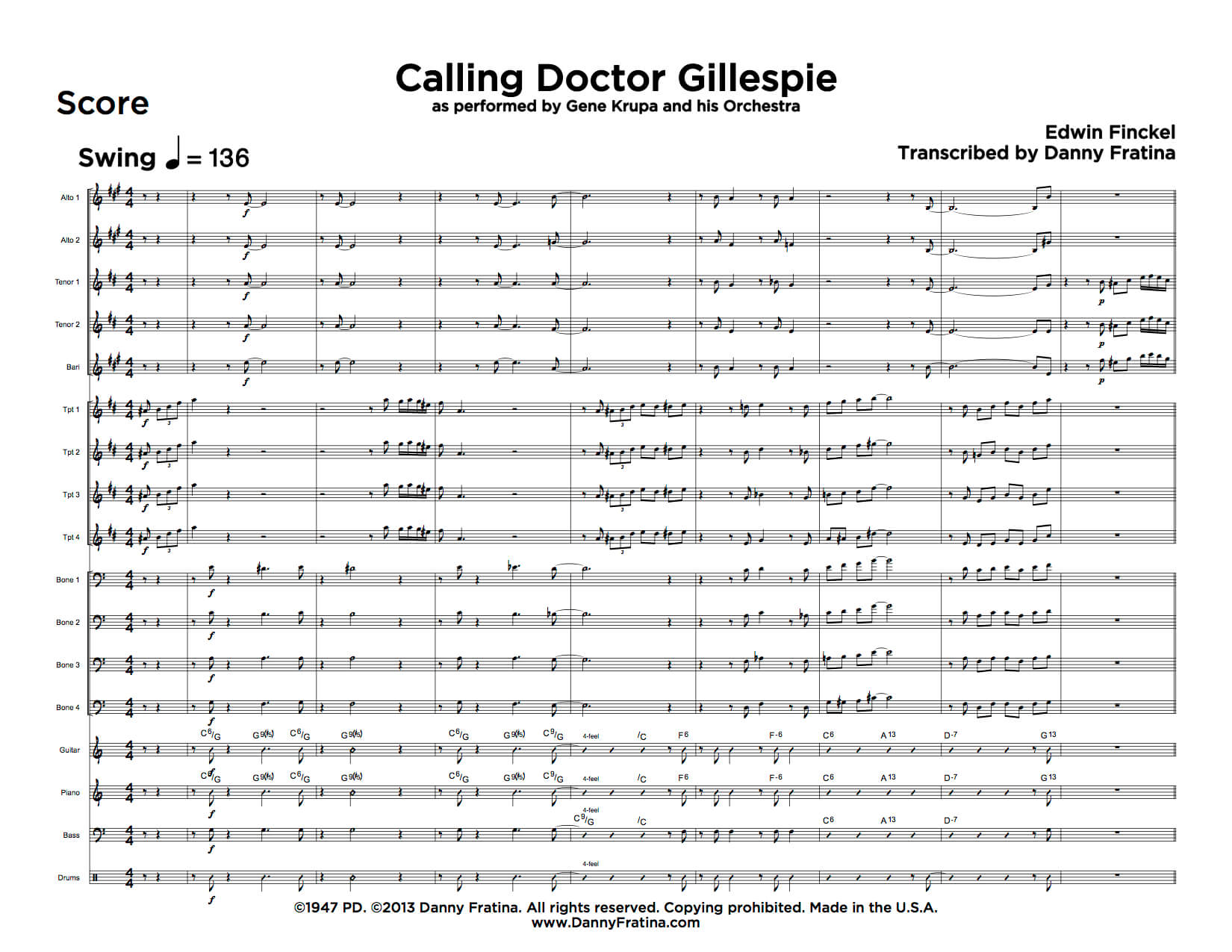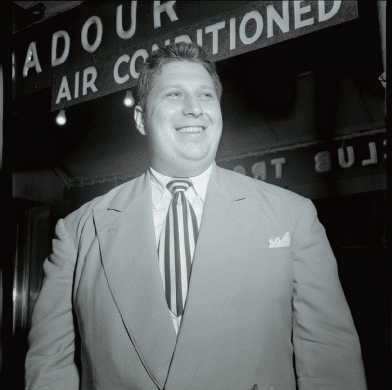
For two weeks in September 1948, the Miles Davis Nonet, a semi-informal group of young jazz musicians coming of age in the early days of bebop, played a live set, about an hour or so long, of newly-composed music that would ultimately be a significant contribution to the evolution of jazz. Tiny Khan, I believe, was not only a fan of this music, but would quickly synthesize it and quietly insert himself into the history of jazz arranging.
Background
In August of 1949, Tiny Kahn wrote an arrangement of Over the Rainbow for Charlie Barnet. Barnet said it was one of the best things in his band’s book. It’s really hard to find the recording they made, but lucky for you, I have a copy. (As of 2019, it’s available all over Youtube now!) You need to listen to this.
Over the Rainbow
Wow.
A lot of the sounds you’re hearing are not especially new to our modern ears, but in 1949 they were risky, they were unpredictable, and they were bold. The “Third Stream” movement, the blending of jazz and classical (jazz orchestras moving towards chamber music ensembles and away from dance or even bebop ensembles), was still a few years away. Charlie Barnet was a famous swing era bandleader who was the first to popularize Cherokee (as a dance piece, several years before Charlie Parker would crank up the tempo). And here he is letting a 25 year old Tiny Kahn bring his own sound in to cover the most popular song in music history. Past, present, and future, all in one moment.
The intro – Chasing the storm away
There are a lot of cool things to talk about in this arrangement, so with a little historical context in place, let’s check out a few.
To start, listen again to that single bar before the melody finally comes in (~22 seconds in) – what the heck is that amazing, melancholy chord? The key of the tune at this point is F. The melody at [A] starts on an FMaj9 (with F in the melody, normally a no-no in arranging but it works because of the extremely strong trumpet presence). The bar before is a solid Eb-9. I’ve transcribed a ton of music from the 30s and 40s, and I can’t think of such a prominent use of bVII-7, leading to IMaj, if at all.
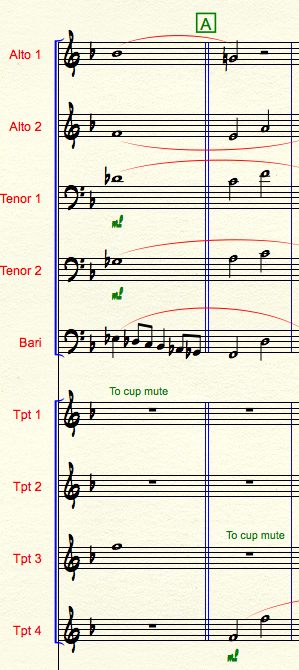
It’s orchestrated with spread voicings in saxes and trombones, a technique that gives more space for both the key note of F in the harmon muted trumpet and a line in the bass, bari, and one trombone, that is simply the Eb Dorian scale moving down to connect with the F chord. It is unexpected after that twisting intro and especially in retrospect after leading directly into Over the Rainbow’s well-known melody. It’s carefully constructed and seamlessly connects the intro to the melody. Sonically, it’s not a harsh sound – it’s the end of a storm clearing the way for that rainbow.
And maybe it’s just me, but I’m hearing hints of Moon Dreams here.
Reharmonizing a classic
Moving on – Right away in the 2nd bar of the melody you hear some colorful passing chords. To understand what’s happening here, look at the third bar. The target chord is BbMaj7. Here is a stripped down version (not what you hear on the recording), with the first three original chords plus the target chord in bar 3.

In reharmonization theory, you can preface almost any chord with it’s related V7, and also in theory you can preface THAT chord with it’s related II-7. So if you applied that to the Bb chord, in this case you would expect to see the II-7 V7 simply added in to the empty space before the target, like so:

In a more advanced piece of reharm theory that emerged out of the more creative swing era arrangers, you can also preface any II-7 V7 set of chords with a II-7 V7 up a half step. This bit of modern theory is well established now in 2013, but was not common until the mid-50s (The half step II-7 V7 idea was used liberally in the Birth of the Cool sessions). In this case you would expect to see Db-7 Gb7 C-7 F7 | BbMaj7. However, because of a lack of space to place these new chords, this completely erases the A-7.

Now, this creates vertical chord scale clashes with the melody, especially beat 3 where the E natural in the melody sits with the C-7 chord. This is normally a major no-no in reharm theory, where all reharms first and foremost must serve the melody. Hold that thought for a moment…
Aside from the melody clash, this is a very clever reharmonization that is completely functional and completely logical. There are controlled dissonances here that (mostly) work with the melody. It’s a well-crafted moment that speaks to Tiny’s amazing ear and incredible capacity to learn the quickly-evolving language of jazz.
But it’s not that simple. We have the issue of the melody/harmony clashes Khan has introduced. To solve this, Tiny erases the two dominant chords from the rhythm section and puts the A-7 back in place. Then, he implies those missing dominant 7 chords with lead alto (the only player with 8th note motion). So we are left with Db-7 C-7 | BbMaj7, with the original A-7 maintaining the space it started with, and the sound of the missing dominant chords filled in with the alto. The melody notes are now all within the vertical chord scales established by each beat’s chord.

This is a small moment, but I’m still awed by it. Here, Tiny manages to to push the arrangement forward in this little burst of color and motion and stay totally within the boundaries of his language. The technical functionality of the moment is still completely intact, the melody is not obscured or destabilized, and there is a great flash of color that doesn’t hit you over the head. This is pure balance.
The most practical explanation for Tiny’s choice here of erasing the two dominant chords entirely is probably to avoid having the rhythm section play 8th note chords that jump around the circle of 5ths. The most artistic explanation is that by emphasizing the II-7 chords instead of the V7s, he squeezes fresh colors out of a familiar tune. He gets something slightly more ambiguous and something that verges on predicting the sound of the hybrid chord, which would not become popular for almost two more decades (obviously he cannot foresee the future of harmony, but his ears surely understand the many reasons why this simply just sounds good).
Kahn uses this little technique 4-5 more times in the arrangement and it’s constantly refreshing.
The peak – A masterclass in modulation
My favorite moment of this arrangement, that solidifies it as one of my favorite arrangements of all time, is the peak moment 2 minutes and 10 seconds in. Tiny gives us a modulation to the key of Bb major with huge concerted horns giving you that classic original melody for a solid three beats. And then it modulates mid-phrase, mid-bar, to the key of C major. Using only functional -7 chords.

We need to break this down.
The arrangement up to this point has been in the key of F. At the start of the phrase we arrive at Bb6, cementing the modulation. On beat 3 we get G-7. This is totally expected. Check out the trumpets:
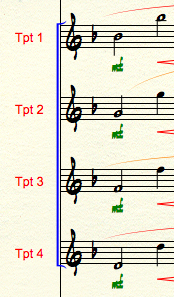
Now look at the trumpets and saxes going forward:
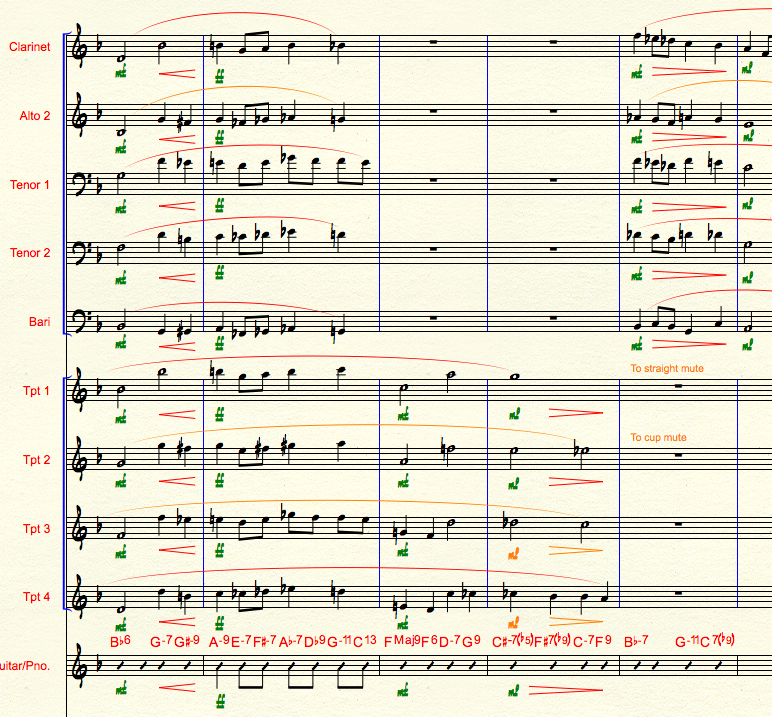
Ignoring the horns and orchestration for a moment – using the chords at the bottom, follow along with me as we’ll be skipping around.
When Tiny hits that first G-7, the normal VI-7 of the tune in the current key, he immediately starts to move the harmony chromatically upwards. He’s taking a variation of the chromatic II-7 idea from before but going backwards with it, moving upwards instead of downwards. Dovetailing this harmonic motion is the 1st Trumpet part, which holds steady on a Bb as the note becomes the 9 (enharmonic A#) over the G#-9 chord.
Jumping ahead to bar 3 shows us the target chord Tiny wanted – FMaj9 – and to arrive there, beats 3 and 4 of bar 2 reuse the familiar reharmonization trick we looked at in the last section of this article.
What is unique here is that beat 2 of bar 2 employs a “constant structure” that is locked to the trumpet melody. Constant structure, first codified into theory by Joseph Schillinger, is the concept of starting with, or ending with, a specific chord and then adding chords before or after it that are A) the same quality and B) separated (usually) by a consistent intervallic jump. This constant structure is a -7 chord that moves by whole step and it is used to connect into the familiar reharm chunk of beats 3 and 4. Everything so far locks together perfectly. (As for the two dominant chords in bar 2, I’ve written those out here just for clearer reference.)
Finally, by bar 3, we are in the key of C. We never get a C chord, amazingly enough, but we are in the key of C purely by the strength of the trumpet melody and the strength of the F chord (the IV in the key of C) landing exactly where it should in the phrase timing.
Khan does not stay here long though. By bar 6 we are definitely back in F, the original key of the arrangement.
So to recap: in 6 bars we get a modulation to Bb, C, and F. The keys of Bb and C are both related to F (sub-dominant and dominant), making it easier to pull off this series of incredibly mature transitions. We also have the loudest point in the entire performance here, signifying a true peak. Ironically it happens in the midst of these seemingly-unstable key changes – or perhaps it’s not ironic, but purposeful, as the power of heavy harmonic changes pairs nicely with dynamic extremes.
Simply put, this is outrageous and spectacular. This is the self-taught Tiny Kahn taking everything he had heard around him, in 1950, around the age of 25, and elevating technique into pure progressive musical expression. He worked within the boundaries of the jazz orchestra, and gave us this. It’s perfectly functional and will give me chills for the rest of my life. And ultimately, I’ve transcribed the entire arrangement only to discover that a bar doesn’t go by where you can’t find incredible attention to detail and an unbelievable ear at work.
Conclusion
I have no way of knowing if Tiny Kahn ever caught a set of the Davis Nonet at the Royal Roost. I have no way of knowing if Tiny Kahn listened to the studio recordings that were released by Capitol throughout the first half of 1949. It’s possible that the connection I’m trying to make here is tenuous and presumptive. With or without the connection, Tiny Khan hear this music in the scene and picked up on it instantly. Kahn’s contribution to jazz arranging by 1950 is outstanding, and a brighter spotlight deserves to be shone on it.
That said, I believe there is an even stronger case to be made looking in the other direction – not just the music that influenced Khan, but the influence Khan had on jazz going forward. Stay tuned for Part III, a look at the clear connections between Tiny Kahn and the composer/arranger who would outlive and outshine him – Bill Holman.
See also:
The Immeasurable Legacy of Tiny Kahn, Part I
